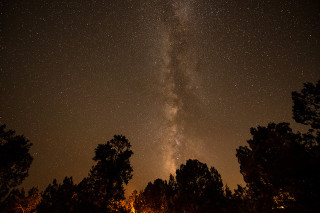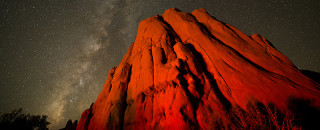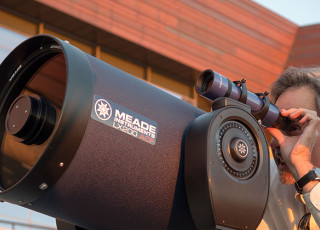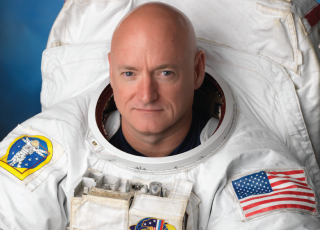Lights Out—Utah's Unique Dark Skies
By Westin Porter
The Natural History Museum of Utah's mission is to "illuminate the natural world and the place of humans within it." Every Museum exhibit, object, and outreach initiative stems from that goal. However, the new Dark Skies exhibit in NHMU's Sky Gallery invites guests to illuminate by turning out the lights. In this way, the natural world and the sky it hangs in illuminates us.
Today the Milky Way is only visible to 20% of Americans according to a recent study by the Light Pollution Science and Technology Institute. It is hard—impossible really—to comprehend or quantify the value that our ability to gaze upon dark sky has had on humanity. People from every part of the world have used the night sky to make sense of themselves and of the universe. It is quite possibly our oldest tool for doing so.
Yet while it may not be possible to fully understand the value of darkness, understanding the negative effects associated with its absence are. Birds’ migratory patterns, sea turtles’ ability to find water after hatching, trees’ seasonal leafing patterns, even our own human circadian rhythms—these are all impacted by light pollution and have consequences that ripple far and wide across an ecological pond.
That’s why researchers from myriad disciplines founded the world’s first-ever academic center dedicated to the study of dark skies—the University of Utah’s Consortium for Dark Sky Studies (CDSS). Since its inception in 2015, the CDSS has been dedicated to the discovery, development, communication, and application of knowledge across a wide range of disciplines and professional fields pertaining to the quality of night skies, growing light pollution, and the varied human, animal, and environmental responses to the “disappearing dark.”
Less a single bodied conservation effort and more a multi-faceted approach to raising awareness of dark skies and studying them, CDSS operates from disciplines including biology, urban planning & ecology, economics, architecture & planning, and more. It is what founding member Dave Kieda describes as a “laboratory” for researchers to discuss all of the different issues surrounding dark skies and their increasing disappearance.
In addition to trailblazing efforts centered on the research of dark skies, CDSS also houses the Colorado Plateau Dark Sky Cooperative, a regionally based education and outreach initiative across the Colorado Plateau.

But the importance of dark sky preservation extends beyond protecting regional ecologies. In recent years researchers have dug into mental and physical health implications of disappearing darkness on humans.
“Artificial light at night has vast health implications,” says Bettymaya Foot, founding member of CDSS. “Humans have evolved in a 24-hour cycle of light and dark. All this new artificial light disrupting the natural darkness has implications on human health. It’s been linked to prostate and breast cancer. It’s also been linked to depression, diabetes, and obesity.”
For Foot, the CDSS is more than a conservation effort. “It’s an opportunity for people to reconnect with the universe and a larger whole,” she says. “I think we’re missing that in society today. The night sky gives you that opportunity to experience awe and to experience connection on a universal scale. That’s really a priceless experience.”
With more International Dark Sky Parks than any other place in the world, it becomes easy to see why this constellation of efforts to preserve dark skies resides in Utah. One result of this work is NHMU’s Dark Skies exhibit, which was designed by University of Utah students of the Multidisciplinary Design Program in partnership with the CDSS and NHMU.

The exhibit, which was unveiled in NHMU’s Sky Gallery in April of 2018, is designed to engage guests and raise awareness of our disappearing dark skies. Wrapping some thirty feet across wall and archway, guests can view a Utah skyline and adjust the light pollution (sky glow) that emerges from Salt Lake City with the turn of a knob. When the lights are up, the city illuminates and washes the darkness above it to a nothingness of white-washed black. When the lights are dimmed, a glorious display of blue-black night sky and stars stretches above them.
In this way, guests can see clearly that the solution to preserving our night sky and all its beauty is, as Foot puts it, “literally the flick of a switch.”
Westin Porter is a Digital Science Writer for the Natural History Museum of Utah, a part of the University of Utah in Salt Lake City. Our mission is to illuminate the natural world and the place of humans within it. In addition to housing outstanding exhibits for the public, NHMU is a research museum. Learn more.



